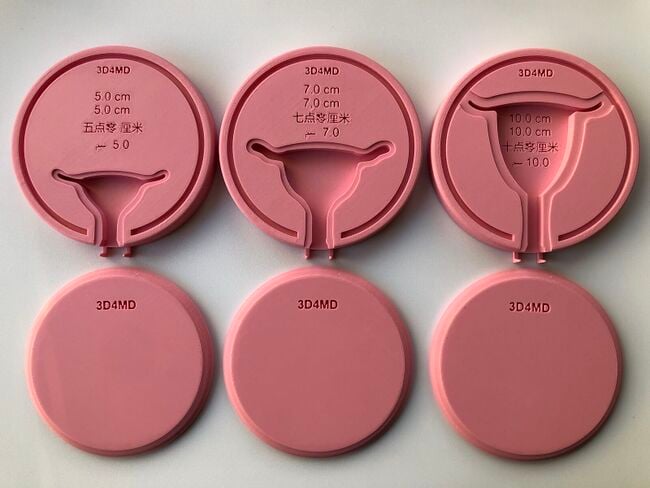3D Printed Uterus Simulators with uterine depths of 5.0, 7.0, and 10.0 cm and lids for blinded insertion.
These 3D printed models accurately simulate a range of uterine depths and widths for nulliparous and parous women.[1] This STARS (Sexual and Reproductive Health and Rights) - Intrauterine Device (IUD) Insertion module's 3D Printed Uterus Simulators will allow nurses, midwives and clinical officers to become confident and competent in maintaining aseptic technique in sounding the uterus, loading the IUD in the sterile package, setting the gauge to the sounded depth, and gently inserting and deploying the IUD as part of copper and hormonal IUD insertion procedures for long-acting reversible contraception performed in low to middle income countries.
Bill of Materials[edit | edit source]
- PLA Filament
In Canada, a 1.0 kg roll of pink PLA costs $17.95 CAD which is equal to about 1.4¢ USD per gram.[2]
In Nigeria, one 750 gram roll of Ultimaker PLA filament (Shore Hardness 83D) costs €33 Euros which is equal to about 5¢ USD per gram.[3][4]
Tools Needed[edit | edit source]
All 3D printed models are designed to be made on any single extruder, fused deposition modeling 3D printer that has a minimum build area of 141 mm by 148 mm.
All the 3D Printed Uterus Simulators are designed to:
- print without support material, rafts or brims
- require no cleaning, sanding, gluing, priming, painting, dipping, coating, smoothing, polishing, or any post-processing
- not require any non-3D printed parts, and
- be ready for use right out of the 3D printer.
Required Skills and Knowledge[edit | edit source]
STL -> G-CODE -> 3D Printer[edit | edit source]
- If you don't have on-site or virtual access to a 3D printer, you can email the 3D file (.STL) to a local 3D printing service with instructions to use the recommended 3D printer settings outlined below.
- If you have on-site access to another 3D printer, you can load the 3D files (.STL) into the printer's slicer program, and input the default settings to create the print file (.GCODE) for your 3D printer.
- If you don't have a 3D printer on-site but can access a remote, connected 3D printer, you can use load the 3D files (.STL) into an open-source cloud client for 3D printers, input the default 3D printer settings, and electronically send the print file (.GCODE) to a local, networked and supported 3D printer.
Technical Specifications and Assembly Instructions[edit | edit source]
Download the 3D files (.STL) and input the recommended print settings to create the print file (.GCODE) for a 3D printer.
3D Model Files[edit | edit source]
| Table 1. 3D Model Files for Basic Set of 3D Printed Uterus Simulators | Component Name | Quantity | File Name | Download File | |
|---|---|---|---|---|---|
| 1 | Lid | 3 | Lid.STL | Coming soonǃ | |
| 2 | Uterus Simulator, 5.0 cm uterine depth | 1 | Uterus Simulator - 5 cm.STL | Coming soonǃ | |
| 3 | Uterus Simulator, 7.0 cm uterine depth | 1 | Uterus Simulator - 7 cm.STL | Coming soonǃ | |
| 4 | Uterus Simulator, 10.0 cm uterine depth | 1 | Uterus Simulator - 10 cm.STL | Coming soonǃ |
Recommended 3D Printer Settings[edit | edit source]
- Materialː PLA
- Print Profileː High Speed
- Supports: None
- Brim/Build Plate Adhesion: Off
- Infill Densityː Default
- Infill Patternː Default
Common Problems and Solutions[edit | edit source]
To prevent printing failures, it's recommended toː
- use fresh PLA filament just out of its packaging
- use a filament dryer before printing to remove moisture that may have accumulated in the PLA filament after removal from its packaging, and
- watch the first several printed layers to ensure proper adhesion of the filament to the print bed.
Cost Savings[edit | edit source]
The total manufacturing costs of this trio set of 3D printed PLA Uterus Simulators (with uterine depths of 5.0, 7.0, and 10.0 cm) is $5.69, $44.39, and $45.00 USD in Canada, Uganda, and Nigeria, respectively. However, these simulators can be re-used indefinitely by multiple learners which makes their per use cost very low.
References[edit | edit source]
- ↑ Parmar, A. M., Agarwal, D. P., Hathila, N., & Singel, T. C. (2016). SONOGRAPHIC MEASUREMENTS OF UTERUS AND ITS CORRELATION WITH DIFFERENT PARAMETERS IN PAROUS AND NULLIPAROUS WOMEN. International Journal of Medical Science and Education , 3(3). Retrieved from https://home.ijmse.com/index.php/ijmse/article/view/148
- ↑ EconoFil™ Standard PLA Filament - Pink - 1.75 mm - 1 kg [Internet]. Filaments.ca. [cited 2021 Dec 11]. Available from: https://filaments.ca/products/econofil-standard-pla-filament-pink-1-75mm-1kg.
- ↑ Ultimaker. Ultimaker PLA Technical Data Sheet [Internet]. Ultimaker Support. [cited 2021 July 29]. Available from: https://support.ultimaker.com/hc/en-us/articles/360011962720-UltimakerPLA-TDS.
- ↑ Kuunda 3D Ltd. Personal communication. July 14, 2021.
